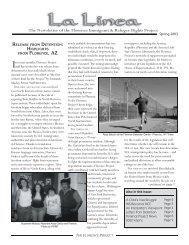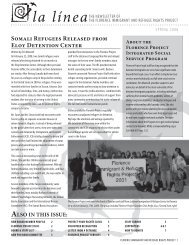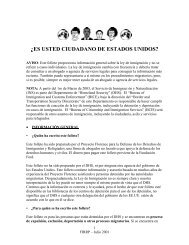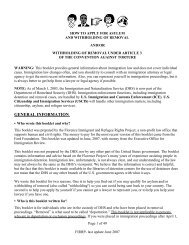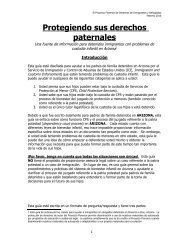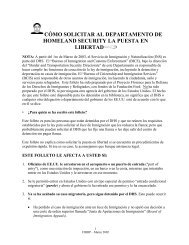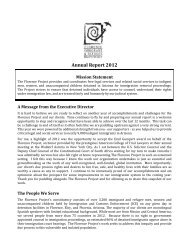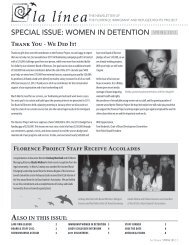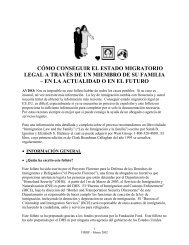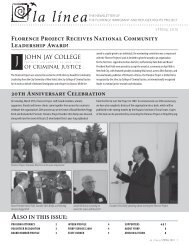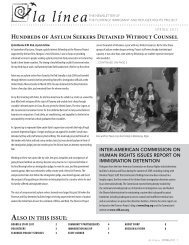quick reference chart and annotations for determining immigration ...
quick reference chart and annotations for determining immigration ...
quick reference chart and annotations for determining immigration ...
Create successful ePaper yourself
Turn your PDF publications into a flip-book with our unique Google optimized e-Paper software.
Immigrant Legal Resource Center, Florence Immigrant <strong>and</strong> Refugee Rights Project,<br />
Maricopa County Public Defender August 2012<br />
class 2 felony if the child is under 15, or if the child is at least 15 years old but the perpetrator is in a<br />
parental or guardianship relationship. Probation or parole is not allowed. Otherwise it is a class 6 felony.<br />
Summary: The statute describes three offenses, none of which require threat, duress or deceit.<br />
In order of the potential severity of <strong>immigration</strong> consequences, the offenses are sexual intercourse or oral<br />
sex with (1) a victim who is 15 – 18 years of age; (2) a victim under the age of 15; or (3) a victim who is<br />
15 – 18 years of age where the perpetrator is a parent or guardian. Each offense must be considered<br />
separately. In some circumstances the first offense might have no <strong>immigration</strong> consequences; the second<br />
offense will have some <strong>immigration</strong> consequences but might escape an aggravated felony; <strong>and</strong> the third<br />
offense will have all possible <strong>immigration</strong> consequences.<br />
If the record establishes that the offense is a class 2 felony because the perpetrator is in a parental<br />
or guardianship relationship, it is likely that the offense will be held sexual abuse of a minor<br />
Crime Involving Moral Turpitude (CMT): Sexual conduct between a parent or guardian <strong>and</strong> a<br />
child always will be considered a CIMT. Consensual sexual conduct with a person under the age of 15<br />
or 18 may or may not be a CIMT. In Quintero-Salazar v. Keisler, 506 F.3d 688 (9th Cir. 2007) the court<br />
found that Calif. Penal Code § 261.5(d), which prohibits consensual intercourse between a person under<br />
the age of 16 <strong>and</strong> a person at least 21 years of age, is not categorically a crime involving moral turpitude.<br />
However, in Matter of Silva-Trevino, 24 I&N Dec. 687, 705 (A.G. 2008), the Attorney General found that<br />
any offense in which an adult engages in intentional sexual contact with a person who the defendant knew<br />
or should have known was a minor will constitute a crime involving moral turpitude. Under Silva-<br />
Trevino, the <strong>immigration</strong> judge may hold a hearing <strong>and</strong> question the defendant (now respondent) as to<br />
whether he knew or should have known that the victim was under-age. If in fact the defendant was not<br />
aware, it would be best to put evidence of this in the criminal record, in hopes of creating a record that the<br />
<strong>immigration</strong> judge would feel constrained to accept. If this is not possible, counsel should make a vague<br />
record as to the defendant’s knowledge of the victim’s age. Counsel also should keep the record vague<br />
<strong>and</strong> avoid an adverse record of conviction (e.g., a younger victim, greater age difference, or other adverse<br />
factor).<br />
Aggravated Felony: Sexual Abuse of a Minor.<br />
Victim 15-18 years of age: The Ninth Circuit held in Rivera-Cuartas v. Holder, 605 F.3d 699<br />
(9th Cir. 2010) that a conviction <strong>for</strong> sexual conduct with a minor under 13-1405 is not categorically an<br />
aggravated felony since it does not match the generic definition of “sexual abuse of a minor” found at 18<br />
U.S.C. § 2243 <strong>and</strong> it includes conduct that would not qualify as “physical or psychological abuse,”<br />
particularly against an older adolescent. The generic definition of “sexual abuse of a minor” is set out in<br />
18 U.S.C. § 2243, which requires that the victim be between the ages of 12 <strong>and</strong> 16 <strong>and</strong> at least four years<br />
younger than the defendant. Since the Arizona statute is lacking these elements, a conviction under § 13-<br />
1405 should not categorically constitute an aggravated felony as “sexual abuse of a minor.” However, if<br />
the record of conviction shows that the victim is 15 <strong>and</strong> the defendant is 4 years older, ICE may claim that<br />
United States v. Aguila-Montes de Oca, 655 F.3d 915 (9th Cir. 2011) (en banc) partially overturned<br />
Rivera-Cuartas such that it is an aggravated felony. Defense counsel should try to cleanse the record of<br />
any mention of the age of the victim or defendant at the time of the offense.<br />
Victim under 15: If the record indicates that the victim is 14, <strong>immigration</strong> counsel may have<br />
arguments that it is not sexual abuse of a minor. But if the record indicates the victim is 13 or younger, it<br />
will be sexual abuse of a minor. If counsel must plead to this subsection, try to keep the record vague as<br />
Arizona Criminal Chart with Explanatory Endnote – August 2012<br />
39



